In short, a soft 17 is any hand that has a total value of 17 and contains an Ace. For example, a hand of Ace + 6 is a Soft 17. Why is this important?
Well, an Ace can be counted as both 1 and 11 according to most blackjack rulesets. In most cases, it starts out at an 11 and is switched over to a 1 if you bust and go over 21. This is what makes an Ace such a universally powerful card. Not only is it the only way to get a blackjack, but it also adds a safety net against busts.
Soft 17 rules are universal in regards to what soft 17 means in blackjack. It always means the same thing, period. However, table rules may vary in regards to whether a dealer stands or doesn’t on a soft 17.
Soft 17 vs Hard 17
When determining blackjack rules, pay close attention to the term Soft and Hard 17. This means that the value of an Ace can be both 1 and 11 and will help you create better hands.
With Hard 17, the cards used will not contain an Ace, such as hands that have 10 and 7, 9 and 8 and so on.
The soft 17 is only created with an Ace. The Ace does not always equal 11, as sometimes it can be worth 1, as discussed above.
In fact, any hand that uses an Ace is considered a “soft” hand. For example, an Ace and a 6 are soft 16, and so on. It is important for players to know the difference between soft and hard hands so they can better understand game rules and know which strategies to use when playing for real money.
Soft 17 Rules
Soft 17 rules in blackjack tables generally come in two variants depending on dealer behavior. In all cases, the dealer must stand on a hard 17. However, the dealer’s behaviour in case of a soft 17 changes.
Most live casino blackjack tables these days force the dealer to stand on a soft 17. This is usually written right in the middle of the table because it’s a relatively important rule. Note that some tables state that the ‘dealer must stand on all 17.’ This includes both hard and soft 17s, so such tables are identical to ones that state the dealer must stand on a soft 17. We are yet to see a rule variation in which the dealer does not stand on a hard 17.
If the table only says that the dealer must stand on a hard 17, it generally means they hit on a soft hand. We trust you can figure out what this means – the dealer stands on a hard 17, but hits on a soft 17.
Are ‘Dealer Hits on Soft 17 Tables’ Better?
Most tables these days force the dealer to stand on a 17 even if it’s soft. It’s a good thing, too – this is a favorable rule for players.
Being able to hit on a soft 17 benefits the dealer in most cases as it allows them to hit and possibly get a better hand without risking going over 21. If they happen to go over 21, the Ace simply counts as 1 and the dealer does not bust.
However, when the proper strategies are used, the rule does not alter the chances for the player much, especially when playing games that use fewer decks of cards. The statistical advantage of Soft 17 rules is minuscule. That said, advantage players know that every little bit helps.
Conversely, a “dealers stand on soft 17” rule favors the player over the dealer. The house edge is slightly smaller in this case.
All in all, variations of the rules and features can have profound impact on how you should approach your game plan. You can find more info about blackjack variations here.
Soft 17 Best Strategy Plays
It’s time to talk about blackjack strategy. Let’s start by imagining a table on which the dealer hits on a soft 17.
The Soft 17 strategy will depend on several factors, such as the value of the player’s/dealer’s cards and the Soft 17 rule, which directs the dealer’s next move. In other words, the dealers are not at liberty to make their own choices about hitting or standing; instead, the game has pre-set rules, which automatically determine the next step.
Unlike the dealers who must follow the fixed pattern, the players have the freedom to strategize, adjusting their gameplay to the dealer’s upcard. Certain Soft 17 strategic rules are universal and should always be implemented – both in the Blackjack variants where the dealer stands on Soft 17, and on the tables where the hand requires them to hit.
The following S17 guidelines can be employed regardless of the variant:
- Hit when you have hard 4 – 8 vs the dealer’s A or 2 through 10 upcard
- Hit when you have hard 9 vs the dealer’s A, 2 or 7 through 10 upcard
- Hit when you have hard 10 vs the dealer’s A or 10 upcard
- Hit when you have hard 12 vs the dealer’s A, 2, 3, and 7 through 10 upcard
- Hit when you have hard 13 or 14 vs the dealer’s A and 7 through 10 upcard
- Surrender when you have hard 16 vs the dealer’s A, 9 or 10. If surrendering is not an option, then hit
- Surrender when you have hard 15 vs the dealer’s 10. Hit if surrendering not allowed
- Double when you have hard 9 vs the dealer’s 3 through 6
- Double when you have hard 10 or 11 vs the dealer’s 2 through 9. Hit if doubling is not allowed
- Double when you have hard 11 vs the dealer’s 10 or hit if doubling is not allowed
- Stand on hard 17 and up
The principles listed above are quite easy to remember as the basic Blackjack rule for all multideck games is to hit when the dealer’s hand is 2 through 7 or an Ace. Soft 17 blackjack essentially uses the same basic strategy.
Surrendering – Yes or No?
In addition to the soft 17 rule, one major difference between various twenty-one tables is whether surrendering is an option or not. If it is, you’re in luck – having the option also works in the player’s favor.
The tips we listed above cover both possible scenarios – tables that allow surrendering, and those that don’t. If you want to know more about the surrender option in blackjack, check out this article.
Soft 17 Blackjack Tips
Speaking of tips, the strategy is just as easy if you are the one holding the Soft 17.
- Player’s Soft 17 vs 2 – hit
- Player’s Soft 17 vs 3 – double down
- Player’s Soft 17 vs 4 – hit
- Player’s Soft 17 vs 5 – double down
- Player’s Soft 17 vs 6 – hit
- Player’s Soft 17 vs 7 – hit
- Player’s Soft 17 vs 9 – hit
As one can easily conclude, there is virtually no standing on Soft 17 for the players. The reason is simple – there is no risk of busting (unlike with the hard hands), and the extra card can significantly improve your odds of beating the house.
Conversely, hitting a hard 17 is an obviously terrible idea – you’re almost sure to bust.
Dealer Stands on Soft 17 Blackjack Variant – When to Stand, Double, Split or Surender?
Once again, we need to turn our attention to the dealer’s upcard and our hand. Generally speaking, soft hands are easier to handle, as hitting is almost always the best option. There are, however, some exceptions, and doubling would be the best move under the following circumstances:
- The player holds a soft 13 – 17 hand and the dealer’s upcard is 5 or 6
- The player holds a soft 15 through 17 hand and the dealer’s upcard is 4
- The player holds a soft 17 hand and the dealer’s upcard is 3
- If doubling is not permitted, the players should hit instead.
Doubling is also recommended on soft 18 but only if the dealer’s upcard is 3 – 6. Otherwise, the player should stand or hit on the dealer’s 9, 10, or Ace. The soft 19 is generally considered a favourable hand and the majority of players will decide to stand.
When to Split?
Most pairs should be split in the Blackjack variants which require the dealer to stand on Soft 17. The question is – when not to split? Once again, we should look at the dealer’s hand for guidance:
- 2,2 or 3,3 – split if the dealer’s upcard is 4 through 7; the same pairs should be split if the dealer’s upcard is 2 or 3 and the players are allowed to double after a split. If not, then hit. 2,2 / 3,3 pairs vs dealer’s A, 8, 9, and 10 should be hit.
- 4,4 – play separately if doubling is allowed after a split and the dealer’s upcard is 5 or 6. Otherwise hit.
- 6,6 – split if doubling is allowed after a split and the dealer’s upcard is 2, otherwise hit. The same pair should be split on dealer’s 3 – 6 or hit on Ace, 7, 8, 9 and 10
- 7,7 – split if the dealer’s upcard is 2 – 7, hit otherwise
- 8,8 – always split
- 9,9 – always split unless the dealer’s upcard is 7, 10, or A, in which case you should stand
- A,A – always split
In short, basic blackjack strategy changes based on whether you’re playing soft 17 blackjack or not. The differences are minuscule, but you can find them on the chart below.

You can also use our blackjack strategy calculator tool to find out how different rule variations affect basic strategy charts.









































 Roulette
Roulette
 Blackjack
Blackjack
 Baccarat
Baccarat
 Poker
Poker
 Sic Bo
Sic Bo
 Dragon Tiger
Dragon Tiger
 Game Shows
Game Shows  Top 5 Games
Top 5 Games  See more
See more  Roulette Casinos
Roulette Casinos  Low Limit
Low Limit  High Limit / VIP
High Limit / VIP  Exclusive
Exclusive  How to Play
How to Play  Basic Strategy
Basic Strategy  Top Tips
Top Tips  FAQ
FAQ  Blackjack Casinos
Blackjack Casinos  Baccarat Casinos
Baccarat Casinos  Bonuses
Bonuses  Poker Casinos
Poker Casinos  Game Providers
Game Providers  Sic Bo Casinos
Sic Bo Casinos  Dragon Tiger Casinos
Dragon Tiger Casinos  Credit and Debit Card
Credit and Debit Card  e-Wallet
e-Wallet  Cryptocurrency
Cryptocurrency  Bank and Checks
Bank and Checks  Pay by Phone and SMS
Pay by Phone and SMS  See more
See more  How-To Guides
How-To Guides  Top Lists
Top Lists  In-Depth
In-Depth  Strategy
Strategy  Casino & Games
Casino & Games  Insight
Insight  News
News  Promotions
Promotions 
 Guide to Live Casinos
Guide to Live Casinos  Top 10 Live Casino Tips
Top 10 Live Casino Tips  Studio Locations
Studio Locations  FAQ & Help
FAQ & Help  Meet The Dealers
Meet The Dealers  Our Awards
Our Awards  How We Rate
How We Rate  Responsible Gambling
Responsible Gambling 




























 ENG
ENG 




 Facebook
Facebook
 Pinterest
Pinterest
 Twitter
Twitter
 LinkedIn
LinkedIn
 Copy Link
Copy Link 




























